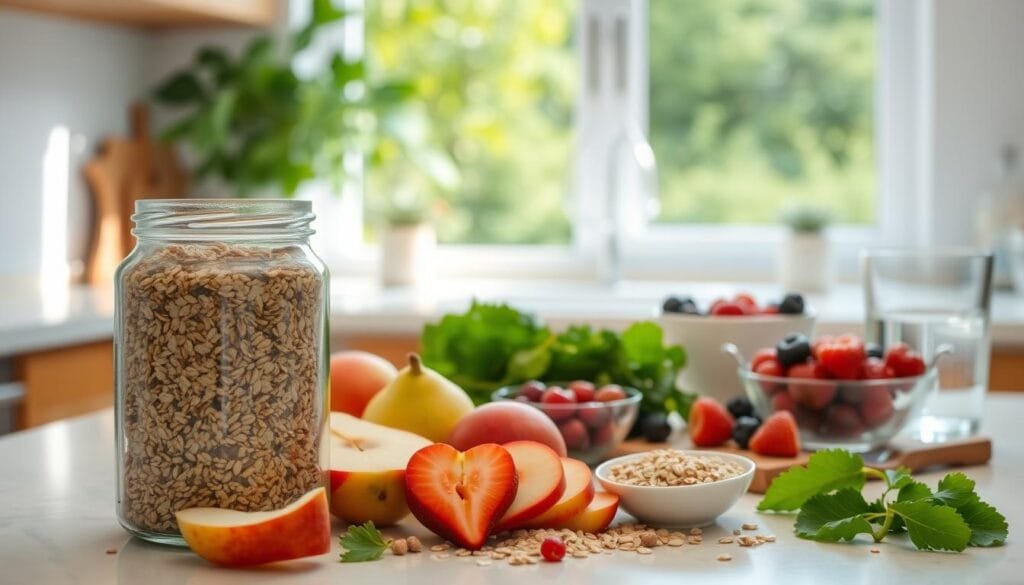Currently Empty: RM0.00
Many people struggle to meet their nutritional needs through diet alone. Current statistics reveal that most adults consume far less than the recommended 28 grams of plant-based nutrients daily. This gap can lead to digestive discomfort, energy fluctuations, and long-term health challenges.
Wellness Concept simplifies the process of balancing your nutritional intake. Their team evaluates individual lifestyles, dietary habits, and wellness goals to create tailored plans. This personalized approach helps avoid common pitfalls like overconsumption or mismatched solutions.
Understanding how much to incorporate into meals requires more than generic advice. Factors like age, activity levels, and existing food choices play a critical role. For example, someone eating plenty of whole grains may need less additional support than a person relying on processed foods.
Residents in Malaysia can connect with Wellness Concept via WhatsApp at +60123822655. Their experts are available Monday-Friday (9:30 am–6:30 pm) and weekends (10 am–5 pm) to answer questions or adjust plans. Small, sustainable changes often yield the best results over time.
Key Takeaways
- Most adults consume less than half the recommended plant-based nutrients daily.
- Personalized plans prevent digestive strain and improve long-term wellness.
- Existing eating habits determine how much additional support you need.
- Professional guidance simplifies balancing nutrition with lifestyle demands.
- Local support is available through flexible consultation hours.
Understanding the Role of Dietary Fiber in Your Health
One essential nutrient plays a dual role in both immediate comfort and long-term vitality. Dietary fiber quietly powers digestive efficiency while guarding against chronic conditions. Its impact stretches far beyond occasional regularity, influencing everything from energy stability to cardiovascular resilience.

Benefits of Fiber for Digestion and Weight Management
Plant-based nutrients act as internal custodians, sweeping waste through your system efficiently. This natural cleansing process prevents sluggish digestion while creating a sense of fullness. By slowing calorie absorption, these compounds help manage hunger signals and support healthy weight goals.
Studies show consistent intake correlates with improved gut bacteria diversity. A thriving microbiome strengthens immune responses and may even influence emotional well-being. “The gut is often called the second brain for good reason,” notes a recent nutrition journal review.
Soluble vs. Insoluble Fiber: What You Need to Know
Two distinct types work together like a precision team. Soluble varieties blend with water to form a gel that traps cholesterol and moderates blood sugar spikes. Insoluble counterparts add bulk to stool, accelerating waste removal and reducing constipation risks.
| Type | Primary Action | Key Benefits | Common Sources |
|---|---|---|---|
| Soluble | Absorbs water | Lowers cholesterol Balances blood sugar | Oats, apples, beans |
| Insoluble | Adds bulk | Prevents constipation Supports colon health | Whole grains, nuts, vegetables |
Combining both types creates synergistic effects. For heart health, soluble types help clear arterial pathways while insoluble varieties reduce inflammation. Together, they form a protective shield against diabetes and certain cancers.
Optimizing Your “fiber supplement daily dose” for Daily Wellness
Getting the right nutritional balance requires more than guesswork. Age, gender, and eating patterns all shape how much your body needs to thrive. Precision matters—too little leaves gaps in wellness support, while too much may cause discomfort.
Recommended Intake Guidelines and Calculations
Health experts outline clear targets for different life stages. Women under 50 should aim for 25-28 grams per day, while men in the same age group need 31-34 grams. After 51, these numbers adjust slightly to match metabolic changes.
Here’s how to calculate your needs:
- Track current consumption of whole grains, fruits, and vegetables
- Subtract this amount from your age-group target
- Add small increments gradually to avoid digestive stress
Children require 14-31 grams per day depending on growth phases. “Food sources should always come first,” advises the American Heart Association. Supplements work best when filling specific gaps rather than replacing meals.
Most people only get half their recommended amount. Adding 10-15 grams through smart choices often bridges this gap. Active individuals might need slightly more, while those with sensitive digestion should increase intake slowly.
Remember—consistency beats perfection. Small, steady adjustments create lasting habits that support gut health and energy levels throughout the day.
Simple Steps to Increase Your Fiber Intake
Boosting your nutritional profile doesn’t require drastic changes. Small, intentional swaps and additions can significantly enhance your meals while supporting digestive health. Let’s explore practical strategies to make this transition seamless.

Incorporating High-Fiber Foods in Your Diet
Start by adding one fiber-rich element to each meal. Lentils deliver 15.6 grams per cup—try them in soups or salads. Raspberries offer 8 grams per cup as a sweet snack. Chia seeds pack 8.4 grams per ounce, perfect for sprinkling on yogurt.
Tips for Balancing Whole Grains, Fruits, and Vegetables
Swap refined grains for barley (6 grams per cup) or quinoa. Keep apple slices handy for quick snacks—their skin provides nearly 5 grams. Roast vegetables like broccoli as flavorful side dishes. “Variety ensures you get both soluble and insoluble types,” notes a nutrition coach.
Effective Use of Fiber Supplements
Supplements work best when filling specific gaps. If you struggle to reach targets through food alone, consider adding a powder or capsule. Always pair them with water and prioritize whole food sources first.
Remember the golden rule: increase intake gradually and stay hydrated. This approach helps your body adjust comfortably while maximizing the benefits of improved nutrition.
Expert Tips from Wellness Concept
Tailoring your nutritional strategy requires understanding how your body responds to different foods. Wellness Concept’s team crafts plans that adapt to your unique digestive patterns and health objectives.
Customized Advice and Support Through Your Journey
Their experts analyze three key factors: current dietary habits, activity levels, and wellness goals. This approach helps identify optimal food combinations to boost fiber per serving without causing discomfort.
For those managing blood sugar concerns, specific recommendations balance soluble and insoluble types. Adding bulk through vegetables like broccoli supports digestion while keeping calories in check. They also guide clients through gradual increases to avoid bloating.
Contacting Wellness Concept: WhatsApp +60123822655 & Business Hours
Connect via WhatsApp for real-time support Monday-Friday (9:30 am–6:30 pm) or weekends (10 am–5 pm). Their team helps you:
- Modify favorite meals to enhance nutritional value
- Choose whole foods over supplements when possible
- Adjust intake based on changing sugar levels or energy needs
“Small tweaks to your fiber diet often create lasting improvements,” shares a Wellness Concept nutritionist. They monitor progress and refine strategies as your body adapts, ensuring sustainable results.
Conclusion
Creating lasting wellness habits starts with smart nutritional choices. Balancing whole grains, fresh fruit, and nutrient-packed seeds helps maintain proper digestive rhythm while supporting heart health. The right diet includes both soluble and insoluble types to manage sugar balance and prevent discomfort.
Variety matters—mix legumes, nuts, and vegetables for diverse sources. Add bulk gradually and pair with adequate water to let your body adjust smoothly. Small changes often create the biggest impact over time.
Wellness Concept simplifies personalized planning. Their experts help determine your ideal intake based on lifestyle and existing meals. Reach out via WhatsApp at +60123822655 during operating hours: weekdays 9:30 am–6:30 pm or weekends 10 am–5 pm.
Remember—optimal wellness isn’t about counting every gram. It’s about building sustainable habits that keep you feeling energized and comfortable throughout the day.
FAQ
How much dietary fiber should someone aim for daily?
Adults are advised to consume 25–38 grams per day, depending on age and gender. For example, women under 50 may target 25 grams, while men might aim for 38 grams. Gradually increasing intake helps avoid digestive discomfort.
What’s the difference between soluble and insoluble types?
Soluble dissolves in water, forming a gel that supports blood sugar balance and heart health. Insoluble adds bulk to stool, aiding digestion. Both are essential, so prioritize a mix of oats, beans, nuts, and whole grains.
Can adding too many high-fiber foods cause issues?
Rapidly boosting consumption may lead to bloating or gas. Start small—like swapping refined grains for quinoa or barley—and drink plenty of water. Supplements like psyllium husk (Metamucil) can help if whole foods aren’t enough.
Are there signs of exceeding the recommended intake?
Overdoing it may cause cramping, constipation, or nutrient absorption issues. Stick to guidelines and adjust based on how your body reacts. Pairing fiber-rich meals with hydration minimizes risks.
How do supplements fit into a balanced diet?
They’re useful when whole foods fall short. For instance, a scoop of Benefiber provides 3 grams. Always check labels for added sugars or calories, and consult a nutritionist if combining multiple sources.
When’s the best time to take a fiber supplement?
Timing depends on goals. Morning doses with water can promote regularity, while evening intake might aid fullness. Avoid taking them with medications, as they could interfere with absorption.
How can Wellness Concept assist with personalized plans?
Their team offers tailored advice via WhatsApp (+60123822655) during business hours. Share your health goals, and they’ll guide you on balancing foods like chia seeds, lentils, and supplements effectively.


